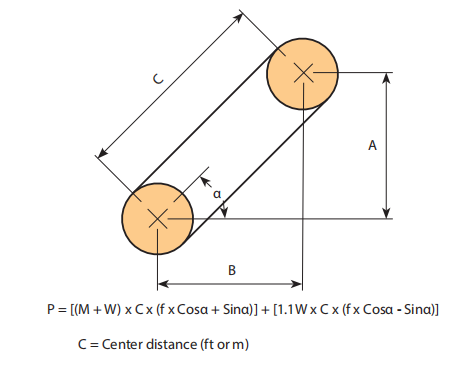Introduction
A cautious evaluation from the disorders surrounding a conveyor is critical for precise conveyor chain choice. This segment discusses the essential concerns expected for productive conveyor chain choice. Roller Chains tend to be utilized for light to moderate duty material managing applications. Environmental conditions may well require using unique supplies, platings coatings, lubricants or the capability to operate devoid of extra external lubrication.
Primary Data Necessary For Chain Selection
? Type of chain conveyor (unit or bulk) like the approach of conveyance (attachments, buckets, via rods and so on).
? Conveyor layout which include sprocket places, inclines (if any) as well as the number of chain strands (N) to get employed.
? Amount of materials (M in lbs/ft or kN/m) and type of material to get conveyed.
? Estimated excess weight of conveyor components (W in lbs/ft or kN/m) including chain, slats or attachments (if any).
? Linear chain pace (S in ft/min or m/min).
? Environment by which the chain will operate which includes temperature, corrosion circumstance, lubrication situation and so on.
Stage one: Estimate Chain Tension
Utilize the formula under to estimate the conveyor Pull (Pest) then the chain tension (Test). Pest = (M + W) x f x SF and
Test = Pest / N
f = Coefficient of Friction
SF = Velocity Component
Step 2: Make a Tentative Chain Variety
Using the Test worth, make a tentative selection by picking out a chain
whose rated operating load higher compared to the calculated Check worth.These values are proper for conveyor service and are diff erent from people shown in tables at the front on the catalog that are linked to slow pace drive chain utilization.
Additionally to suffi cient load carrying capacity generally these chains has to be of the sure pitch to accommodate a preferred attachment spacing. By way of example if slats are to get bolted to an attachment every 1.five inches, the pitch in the chain selected ought to divide into 1.5?¡À. Thus a single could use a 40 chain (1/2?¡À pitch) with all the attachments each 3rd, a 60 chain (3/4?¡À pitch) using the attachments just about every 2nd, a 120 chain (1-1/2?¡À pitch) using the attachments every single pitch or even a C2060H chain (1-1/2?¡À pitch) together with the attachments just about every pitch.
Step three: Finalize Selection – Calculate Real Conveyor Pull
After producing a tentative assortment we need to confirm it by calculating
the actual chain stress (T). To accomplish this we must fi rst calculate the real conveyor pull (P). From the layouts shown within the right side of this webpage pick out the ideal formula and determine the total conveyor pull. Note that some conveyors could be a mixture of horizontal, inclined and vertical . . . in that situation calculate the conveyor Pull at each and every area and include them collectively.
Phase four: Calculate Highest Chain Tension
The maximum Chain Stress (T) equals the Conveyor Pull (P) as calculated in Phase 3 divided through the amount of strands carrying the load (N), times the Speed Issue (SF) shown in Table 2, the Multi-Strand Element (MSF) shown in Table 3 as well as the Temperature Component (TF) shown in Table four.
T = (P / N) x MSF x SF x TF
Stage five: Verify the ?¡ãRated Doing work Load?¡À of your Picked Chain
The ?¡ãRated Working Load?¡À of your selected chain should be greater than the Optimum Chain Tension (T) calculated in Phase 4 above. These  values are suitable for conveyor services and therefore are diff erent from people shown in tables in the front of the catalog which are associated with slow velocity drive chain usage.
values are suitable for conveyor services and therefore are diff erent from people shown in tables in the front of the catalog which are associated with slow velocity drive chain usage.
Step six: Check the ?¡ãAllowable Roller Load?¡À of your Selected Chain
For chains that roll to the chain rollers or on major roller attachments it is essential to test the Allowable Roller Load?¡À.
Note: the Roller load is established by:
Roller Load = Wr / Nr
Wr = The total fat carried by the rollers
Nr = The quantity of rollers supporting the excess weight.
